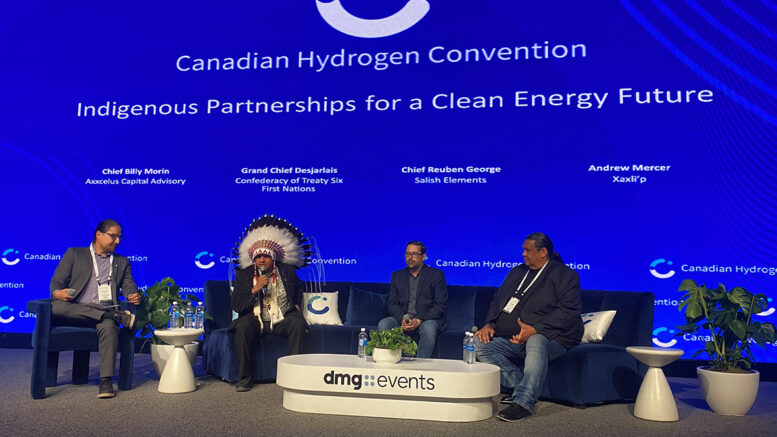By Jeremy Appel, Local Journalism Initiative Reporter
(ANNews) – Less than a week before Billy Morin was elected as the Conservative MP for Edmonton Northwest in the Canadian federal election, the former elected chief of Enoch Cree Nation moderated a panel on Indigenous opportunities in hydrogen.
The Canadian Hydrogen Convention was held on April 23 and 24 at the Edmonton Convention Centre, with the second day including the panel, “Indigenous Partnerships for a Clean Energy Future.”
Grand Chief Greg Desjarlais of the Confederacy of Treaty Six First Nations, Salish Elements chairman and co-founder Rueben George, and Xaxli’p (Fountain First Nation) executive director Andrew Mercer spoke on the Morin-moderated panel.
Salish Elements, an Indigenous-run company that produces green hydrogen—meaning hydrogen that is made with water, rather than natural gas—signed a May 2024 agreement to build a 25-megawatt hydrogen production facility on the Xaxli’p reserve in Lillooet, British Columbia.
“This is the first major business development that we’ll be doing on the traditional territory,” Mercer said, emphasizing that the project will be 51 per cent owned by Xaxli’p.
“It’s not that other companies haven’t come in before and tried to partner or to work with the community. However, none have done it in a way such that Salish is doing it.”
In addition to his role with Salish Resources, Rueben George is the Sun Dance chief of Tsleil-Waututh Nation, a Coastal Salish community based in North Vancouver.
George said his company is working to build hydrogen fuelling stations along the B.C. coast “from Vancouver to Prince Rupert,” and has been in talks with native tribes in the United States “to duplicate what we’re doing in British Columbia in Washington State.”
Mercer emphasized the collaborative approach George’s company took towards the project on the Xaxli’p reserve.
“Folks from Salish Elements come out to the community. They meet with the community, they talk to the community, they address the concerns of the community. They change their model based on the feedback that the community gives, and that’s so important,” said Mercer.
Grand Chief Desjarlais, who’s also chief of Frog Lake First Nations, which is located about 250 km east of Edmonton, emphasized the importance of having Indigenous communities involved in energy projects at every step of the way.
“I always say it’s good to have the indigenous involvement at the beginning of the project, because you don’t want a cranky Indian at the back of the project, because the projects don’t go anywhere,” said Grand Chief Desjarlais.
“That’s the solution—invite the First Nations to the table and offer them some equity position, because there’s money available.”
Under former premier Jason Kenney, the Alberta government introduced the Alberta Indigenous Opportunities Corporation, a Crown corporation that provides loan guarantees for First Nations and Métis communities to invest in equity for energy projects.
Morin, who served as the vice-chair of the Edmonton Region Hydrogen Hub, which aims to grow the local hydrogen industry, when it was established in 2021, said his consulting firm, Axxcelus Capital Advisory, is working with Qalipu First Nation Band in Newfoundland to facilitate Indigenous investment in energy projects in Mi’kmaq territory.
“Indigenous Peoples are not homogenous, but we do cover, obviously, the whole territory of Turtle Island, which is Canada,” said Morin.
Desjarlais said that First Nations Peoples must be “open for business, and that’s how people have to view us.”
“We should be like our Saudi brothers,” said the grand chief. “We should be the richest people on this earth. And that’s what we’re trying to get to.”
He noted that he met with George for 10 minutes, and in that brief time “we already had made a trade between two men, two chiefs.”
Desjarlais is a director of the Western Indigenous Pipeline Group, which is working with Pembina Pipelines to secure an equity stake in the Trans Mountain pipeline expansion (TMX).
George, as a facilitator in renewable energy projects, noted that he’s on the opposite side of the pipeline debate as Desjarlais.
“But look what we did. We put aside our differences, and we’re going to trade some buffalo for some salmon, and that’s what we do as First Nation people,” said George.



Rez clean up first……then respectability !!